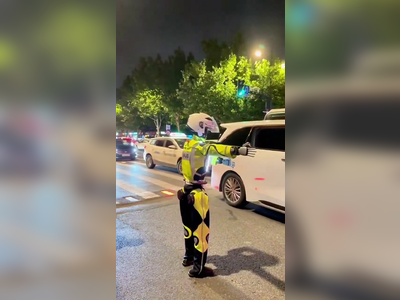Your ‘handmade’ pashmina shawl could be made by machine – one that is costing artisans their livelihoods
The pashmina shawl has delighted women around the world for centuries, from Emperor Napoleon’s wife Josephine to queens and princesses of the British royal family. Empress Josephine, it is said, owned more than 60 of the wraps and her love of them turned the covering into an item of high fashion across Europe.
“At the beginning of the 19th century, wealthy Europeans embraced Kashmiri shawl cloth with as much enthusiasm as Americans who discovered polyester fleece at the end of the 20th century,” writes historian Michelle Maskiell in the Journal of World History.
Renowned for its soft, warm and luxurious feel, the raw material of genuine pashmina cloth comes from a breed of cashmere goats native to the mountainous Changthang region of Ladakh in Kashmir, in India’s far north.
Unlike wool, pashmina fibre is not sheared, but brushed out with wooden combs. It is stored in the form of a loaf resembling candyfloss and then spun. It was once produced by Kashmiri women on a traditional wheel called a yender, but now power looms are more often used.
Today, about 70 per cent of the world’s pashmina fibre comes from China, 20 per cent from Mongolia, 9 per cent from Afghanistan, Pakistan, Nepal and Central Asia, and only 1 per cent from Kashmir.
But experts have heralded the Kashmir pashmina as the finest of them all. The thread produced by the region’s women spinners is 12 to 16 microns in diameter, whereas the thread from the rest of the world is 17 to 20 microns.
In the West, the shawls can cost as much as US$300, while those with fine hand embroidery can go for US$600. The needlework, which can take years, has in the past cost the vision of many artisans, who are sometimes paid less than US$150 a month.
“We had one artisan, who was about 60 years old, and I had commissioned him to do the embroidery on a maroon shawl,” says Nasir Ali, who employs more than 10 embroidery workers in his business in Kashmir.
“It was a very dense work. It took him one-and-a-half years to complete two-thirds of the shawl, but soon after he lost his eyesight. That piece remained unfinished. It’s a masterpiece and no one could work on it except him. The most painful thing for me is that the shawl cost him his eyesight, and he would have barely earned more than US$200 for it.”
The entire process of manufacturing pashmina, from dehairing, sorting, spinning and weaving to dying and embroidery, was once done manually. Now many of the shawls are produced in factories instead of on traditional weaving looms, resulting in a lot of people who have been associated with the craft for 50 years now finding themselves jobless.
The long-troubled region of Jammu and Kashmir was locked down for months last year by the Indian government. A curfew was introduced, telecommunications shut down, social life ground to a halt and businesses folded when the region was brought under the direct control of New Delhi. Against this backdrop of dwindling employment opportunities, the pashmina artisans of Kashmir struggled to keep their craft alive.
Showkat Ahmad Mir, former general secretary of the Union of Kashmir Pashmina Artisans (KPKU), is the third generation of his family to weave pashmina. He started KPKU with his fellow weavers in 2013 and they have been protesting against the mechanisation of pashmina production ever since. Under the 1985 Handloom Protection Act, weaving pashmina on power looms is prohibited.
“It is the government’s apathy that they are not enforcing it,” Mir says. “They are not doing anything about it. The rich industrialists bribe or are friends with the authorities and support them to the fullest, while they are just doing a sort of lip service to this heritage craft.”
The artisans and the pashmina exporters say the authorities have double standards. “On the one hand they are saying that the pashmina is a heritage craft and it should be saved and preserved,” Mir says. “But at the same time, there are government corporations that sell machine-made pashminas and pass them off as handmade.”
After lengthy legal battles, Indian-administered Kashmir was awarded a geographical indication (GI) stamp in 2014. Under the Paris Convention and Lisbon Agreement, the GI mark is used on certain products from a specific geographical location as an affirmation that the items have exceptional characteristics that are not found elsewhere. A GI mark indicates a Kashmiri pashmina is hand-spun and hand-woven, with a fibre diameter of 12 to 16 microns.
Yousuf Ahmad Rather, a weaver from Srinagar in Kashmir, was loaned 100,000 rupees (US$1,330) by the government’s handicrafts department to manufacture pashmina shawls.
“But when the products were ready they refused to buy them,” he says. “Instead, they bought counterfeit pashmina produced on power looms. And if they do purchase our shawls, they want us to sell them for peanuts.
“My own GI-stamped pashmina shawls remained unsold. It seems they don’t want authentic pashmina. So we artisans just don’t go to corrupt government corporations.”
The authorities rarely check whether the shawls being sold by their own corporations are genuine products, he adds. “The world understands that the GI-marked pashmina is the only authentic pashmina. The licences of those selling fake shawls should get cancelled. Why don’t they just do it?”
Many thousands of Kashmiris have been directly and indirectly affected by pashmina mechanisation and government apathy towards saving the craft. Many are women spinners.
“In the past, there were a lot of women who would spin raw pashmina into fine thin threads,” says Mir, who also helps women spinners who have lost their jobs. “It was only because of how deftly they did the job that the Kashmiri pashmina had fibres of 12 to 16 microns in diameter. But now there are very few and many have been jobless for years.”
The yarn was traditionally spun by women on bobbins made of grass. Transferred by men to plastic bobbins, the yarn was then woven by men into warps and wefts to make pashmina cloth. Before mechanisation undermined the craft, many Kashmiri women spun pashmina fibre to help support their families.
“Spinning the pashmina thread was a bedrock for destitute women like me,” says Nasreena, a 45-year-old widow living on the outskirts of Srinagar. “It was considered a way of making an honourable living. But the mechanisation has made this feel like a thing of the past. I get nostalgic whenever my eyes land on the spinning wheel in the attic, and I recall the times when I used to spin the yender.”
It takes about 10 days to make one pashmina shawl on a traditional loom, while eight shawls can be produced in a single day using a power loom. The power loom owners blend pashmina with nylon, viscose and other materials so the fibre becomes strong enough for mechanised weaving.
The power loom fraternity claims it has a licence to manufacture wool cloth, and adds that pashmina is a fibre that comes under the wool category. Yet according to research by the Sher-e-Kashmir University of Agricultural Sciences and Technology in Srinagar, wool and pashmina “are completely different fibres altogether, in terms of genetic nature, appearance, morphology, handle [and] processing”.
As the battle continues, the traditional artisans remain poor.
“I wish I would have studied and not come into this shawl-making,” says Aijaz Ahmad, 28, who has been weaving pashmina shawls at his home in central Srinagar since he was 17. “I am being paid the same wage I was paid in 2010 when I first started weaving. Even if I had become a watchman, I would have been earning more than I earn here.”
When Ahmad got engaged, he had to work part-time as an electrician for a couple of months to buy a gold ring and a smartphone to give his bride.
“There is not a single day in my life when I don’t repent choosing to become a pashmina shawl weaver,” he says.




















